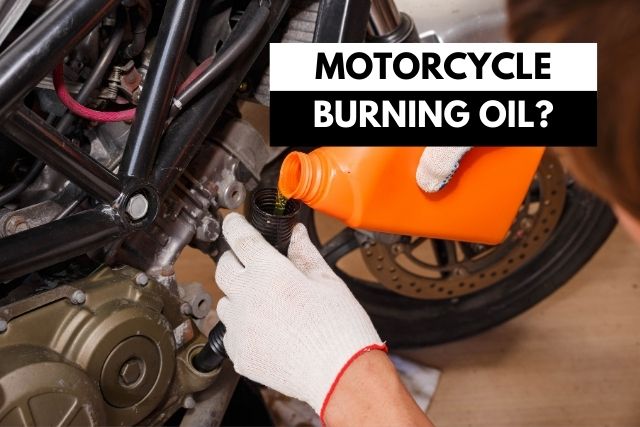Engine oil is the blood of a motorcycle engine. Not the gas.
Oil lubricates the engine components and keeps them healthy.
If the oil is burning in your motorcycle, you should be concerned.
So, in this guide let’s understand:
- Why your motorcycle is burning oil fast – reasons and causes
- Motorcycle burning oil symptoms
- Solutions for burning oil in the motorcycle
Before we dive in, one caveat.
There will always be a small amount of oil burning. It’s okay. You should be concerned only when the oil is burning too fast.
And that’s what this post addresses.
So without further ado, let’s dive right in.
Causes for a burning oil
Let’s start with what causes burning oil in a motorcycle.
Here’s the list:
#1. Damaged piston rings
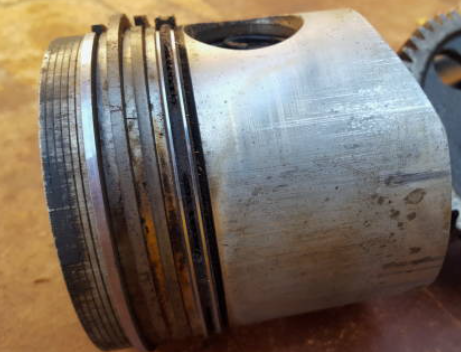
Piston rings seal the gap between the piston’s outer diameter and the cylinder walls.
Why does it matter?
This helps in segregating the combustion chamber and the crank case.
The fuel mixture won’t flow from the combustion chamber to the crankcase. And the engine oil won’t flow from the crankcase to the chamber.
But, if the piston rings get damaged or worn-out, the segregation is no more effective.
So what’s the big deal?
The oil starts flowing from the crankcase into the combustion chamber.
And starts burning.
#2. Poor quality oil
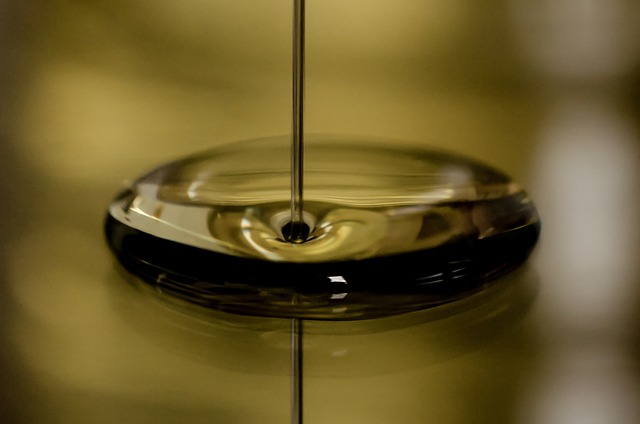
Poor quality engine oil is another problem.
Low quality oil slips into the combustion chamber. And not just there.
There will be lots of oil leaks.
Any gaps, crevices, and openings sufficient for the oil to pass through, it will flow.
Something which a good quality engine oil is unable to do. The uneven viscosity does a lot of difference in how the oil behaves.
And as a result, poor quality oil leads to oil leakage and oil burning.
#3. Worn-out seals and gaskets

Lastly, worn-out seals and gaskets are another cause for both oil leaking and oil burning.
This is simple.
Any damaged or worn out O-rings, valve seals, and gaskets leads to oil flowing through the leak.
And if the leak goes into the combustion chamber, the oil flows there and burns.
Burning Oil Symptoms
Enough with the causes and reasons.
Let’s look at the symptoms.
What gives away and what things to look for when your motorcycle is burning engine oil?
Here are the symptoms which you can use for inspection. And confirm if the oil is indeed burning.
#1. Engine oil depletes fast
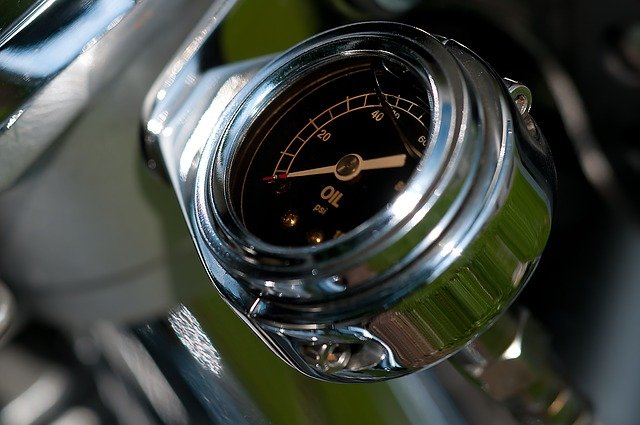
Low engine oil levels.
This is one of the major giveaways.
But, there is a caveat.
Burning oil leads to low oil levels.
But, low oil levels do not necessarily mean burning engine oil.
Anyway, low oil level is a definite symptom of oil burning.
Especially if you have changed the oil and are seeing low oil levels already, there is a definite case of oil burning.
Now, how to check for low oil levels?
You can check the oil dipstick.

Exact checking varies from motorcycle model to model.
But the gist is – remove the oil gauge. Check the wet mark on the gauge. The oil wet mark should lie between the ‘full’ and ‘low’ marks in the gauge.
If the mark is below the low mark, the oil levels are low.
It’s time to check for other symptoms to confirm oil burning.
#2. White smoke from the exhaust
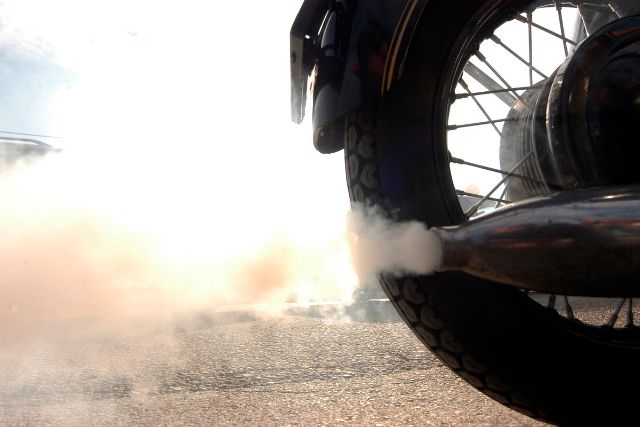
If you see white smoke in the exhaust, coupled with depleting engine oil levels, think no further. Your motorcycle is burning engine oil.
Engine oil burning happens when the oil from the crankcase flows into the combustion chamber.
Within the combustion chamber, the oil burns along with the fuel.
That’s how the engine oil burns.
Since there is loss of oil, you will notice low oil levels.
And where does the burnt oil go?
Through the exhaust of course.
But not without giving a hint.
The burnt oil exits the exhaust in the form of white smoke. You can notice it easily.
And when you notice white smoke from your bike exhaust, there is a case of burning oil there.
#3. Oil color is blackened

Once you have checked the oil levels and noticed white smoke in the exhaust, it is time to assess the oil quality.
To check the oil quality, we go back to the oil gauge.
Dip the oil gauge back into its place. And no need to screw it tight.
Just place it and take it back.
Now the gauge would have collected some oil. Apply that oil on your fingers or a piece of paper or a tissue.
Time to check the oil color.
Let me make this simple.
Here is what different engine oil colors mean.
| Engine Oil Color | What It Means |
|---|---|
| Amber or yellowish | Oil is new |
| Brown or lighter | Oil is in good condition |
| Black or darker | Oil is in bad condition |
| Green or white tinges | Coolant is mixed with engine oil |
#4. Oil has a burnt smell
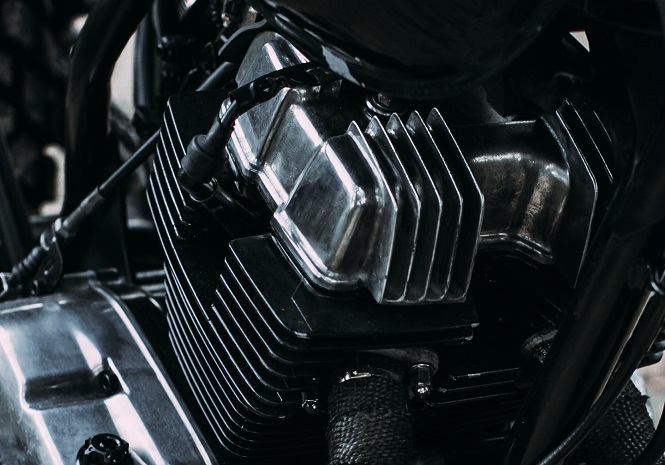
Burnt smell is the final nail in the coffin.
To inspect, repeat the same steps above.
Dip the oil gauge back into its place and take it back. Apply the collected oil on the gauge to your finger or a paper or a tissue.
Now, smell the engine oil.
There is only one simple test here.
If the oil has a burnt smell, then the oil is burnt (duh!).
The oil is not right for the motorcycle. You need to change the engine oil. And also look into the root cause. Check out the solutions section below.
#5. Spark plug is oil fouled or has ash deposits
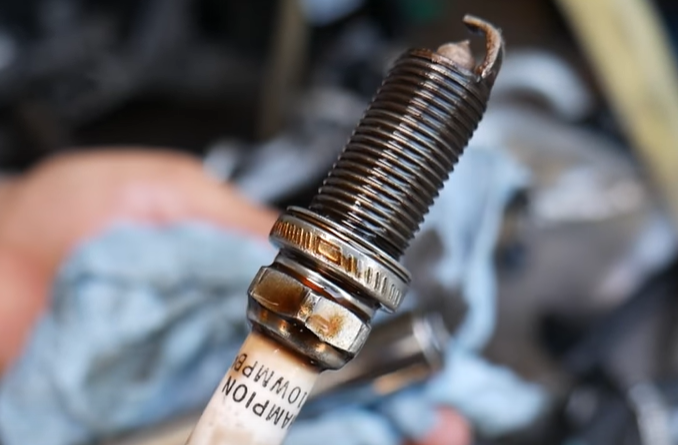
One last symptom.
You don’t have to check this. The above symptoms are more than enough to confirm if the engine oil is burning in your motorcycle.
Still, another symptom of engine oil burning is oil depositing on the spark plug.
When the oil makes its way into the combustion chamber, it eventually finds the spark plug as well. And form deposits there.
If the oil starts coating the spark plug, it results in oil fouling.
If the oil burns and forms deposits, it results in ash deposits.
Now, how to identify these?
Here’s the short manual:
- Oil fouling: deposit on the spark plug is black but wet and slippery.
- Ash deposit: deposit on the spark plug is white, dry, and sandy in texture.
That’s it.
Either of these cases is because oil is entering the combustion chamber.
And if oil enters there, there is going to be oil burning.
Solutions and Preventive Measures
We have discussed the causes and symptoms.
Let’s come to the solutions and preventive measures to address the burning oil problem.
I won’t drag it out. Let’s dive right in.
Here are the fixes you can go for:
- Use engine oil additives: This is a quick fix. There are lots of Teflon-based additives you can use to seal the engine and prevent oil leaks from gaskets. This is of course a short-term solution, but an effective one.
- Go for engine flushing: Engine flushing deep cleans the engine before an oil change. It will remove contaminants and help restore the engine to its peak condition.
- Use high-quality engine oil: If poor oil quality is the issue, it’s time to change the oil. Consider going for synthetic oil if your motorcycle engine works well with it. Also, go for multigrade oil if the winter is harsh in your region.
- Seal the gaskets: This is easier said than done. Go for it only if the oil burning is too high. You need to take your motorcycle to the dealer or a service shop for this. Again, go for it only if the above solutions aren’t effective.
- Replace piston rings: Let’s hope things won’t come to this. But if the engine is old and weak, it might come to this. Replacing piston rings is labor-intensive and costly as hell. Go for piston ring replacement only as the last resort.
Conclusion
If all these causes and inspection feels overwhelming, here is the short route for you:
First, go through the symptoms to confirm if there is oil burning in your motorcycle.
Low oil levels, white smoke from the exhaust, black color oil, and burnt smell.
That’s more than enough to confirm.
For the solution, just go for the oil change. Engine flush before adding the new oil.
And one last addition, go for oil additives that help in preventing oil leaks.
This should be enough for most of the time.
